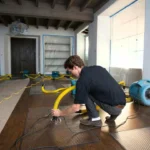A roof inspection is crucial to maintaining your home, ensuring its structural integrity and longevity. Whether buying a new property, preparing for seasonal weather changes, or addressing possible leaks, understanding what occurs during a roof inspection can help you feel more confident. We will explore the essential steps of a roof inspection, covering the areas that will be assessed, the tools used by professionals, and how to interpret their findings. By knowing what to expect, homeowners can better prepare for the inspection and take the right steps afterward to maintain their roof’s condition.
Initial Preparation: Setting Up the Roof Inspection
Before the roof inspection begins, it’s essential to prepare your home and property to ensure the process goes smoothly. The first step is choosing a reliable, experienced roofing contractor to conduct the inspection. It’s important to schedule the inspection when weather conditions are favorable, as roofing professionals need clear skies to access the roof safely. You should also clear any obstacles around your home, such as parked cars or debris, to give the inspector easy access to the roof and surrounding areas. If possible, look at your roof from the ground to identify issues like missing shingles or sagging areas. These preliminary observations can help guide the inspection and provide a starting point for further investigation.
Once the inspector arrives, they will likely assess your home’s exterior briefly, noting any areas that may require attention. They may check for signs of wear and tear, such as curling shingles or damaged gutters, before moving on to a more in-depth examination. This initial preparation is vital to ensure the inspector can focus on the areas that need attention and perform their job effectively.
Visual Inspection of Roof Surfaces and Materials
One of the most important steps in a roof inspection is the visual inspection. A roofing professional will carefully examine the roof’s surface for visible signs of damage or wear. They will look for cracks, holes, or missing shingles that could allow water to seep into your home. The condition of the roof materials will also be assessed, as different materials have varying lifespans and vulnerabilities. Asphalt shingles, for example, can become brittle over time, while clay tiles might crack or shift.
The roofing professional will also check for any signs of algae or moss growth, which can indicate areas of moisture buildup. If left untreated, these growths can weaken roofing materials and contribute to faster deterioration. The inspection might also include checking the roof’s flashing—the metal strips used to prevent water from entering around chimneys, vents, and skylights. Properly installed flashing is essential for keeping water out of vulnerable areas, and a professional will ensure these components are secure and intact.
In some cases, the inspector might use a ladder to inspect certain parts of the roof closer to check for issues that are not visible from the ground. The condition of your roofing materials can give valuable insight into how well your roof protects your home and whether any repairs are necessary.
Checking Roof Structure and Attic Conditions
Beyond the exterior, a roof inspection examines the underlying structure and the attic space. The condition of the roof’s framework is essential for ensuring its overall stability. The inspector will look for signs of sagging or warping, which can be caused by water damage, snow buildup, or even the age of the materials. A sagging roof can signify a more significant problem, such as weakened rafters or decking, that could lead to costly repairs if left unaddressed.
Inside the attic, the inspector will check for signs of moisture or leaks. This is especially important if the roof shows signs of damage, as water can easily penetrate the structure, leading to further issues such as mold growth or rotting wood. The inspector will look for any water stains, mold, or mildew, as these can be indicators of persistent roof leaks. They will also check the insulation, ensuring it’s properly installed and not damp, which could reduce its effectiveness in maintaining energy efficiency in your home.
Proper ventilation is another critical aspect of the attic inspection. Roof ventilation helps regulate temperature and moisture levels, preventing issues like condensation, mold, and premature aging of roofing materials. The inspector will check if the attic is adequately ventilated, which is essential for preventing long-term damage to the roof and your home’s interior.
A roof inspection is essential in maintaining your home’s safety and functionality. By understanding what to expect during a roof inspection, you can be better prepared to address any issues. From the initial preparation to the detailed examination of the roof’s surface, structure, and drainage system, every step plays a crucial role in identifying potential problems and preventing costly damage in the future. After the inspection, take the time to review the findings carefully and take action as needed to keep your roof in optimal condition. Regular inspections can extend the life of your roof, protect your home from water damage, and provide peace of mind.

Shannon Reyes is a seasoned writer with a knack for crafting engaging blogs on a variety of service industries, including plumbing, cleansing, moving, pest control, and roofing. With a keen eye for detail and a passion for helping readers navigate complex topics, Shannon brings her expertise to life through informative and accessible content.










